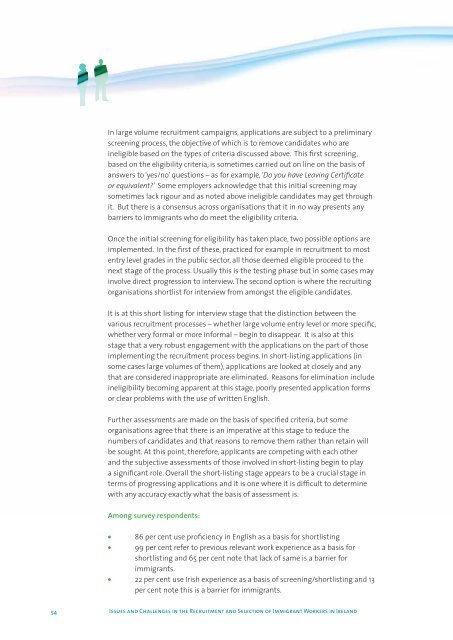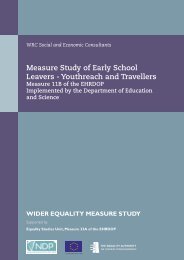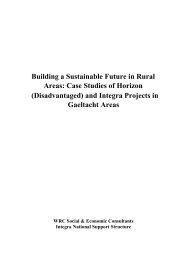Issues and Challenges in the Recruitment and Selection of ...
Issues and Challenges in the Recruitment and Selection of ...
Issues and Challenges in the Recruitment and Selection of ...
Create successful ePaper yourself
Turn your PDF publications into a flip-book with our unique Google optimized e-Paper software.
In large volume recruitment campaigns, applications are subject to a prelim<strong>in</strong>aryscreen<strong>in</strong>g process, <strong>the</strong> objective <strong>of</strong> which is to remove c<strong>and</strong>idates who are<strong>in</strong>eligible based on <strong>the</strong> types <strong>of</strong> criteria discussed above. This first screen<strong>in</strong>g,based on <strong>the</strong> eligibility criteria, is sometimes carried out on l<strong>in</strong>e on <strong>the</strong> basis <strong>of</strong>answers to ‘yes/no’ questions – as for example, ‘Do you have Leav<strong>in</strong>g Certificateor equivalent?’ Some employers acknowledge that this <strong>in</strong>itial screen<strong>in</strong>g maysometimes lack rigour <strong>and</strong> as noted above <strong>in</strong>eligible c<strong>and</strong>idates may get throughit. But <strong>the</strong>re is a consensus across organisations that it <strong>in</strong> no way presents anybarriers to immigrants who do meet <strong>the</strong> eligibility criteria.Once <strong>the</strong> <strong>in</strong>itial screen<strong>in</strong>g for eligibility has taken place, two possible options areimplemented. In <strong>the</strong> first <strong>of</strong> <strong>the</strong>se, practiced for example <strong>in</strong> recruitment to mostentry level grades <strong>in</strong> <strong>the</strong> public sector, all those deemed eligible proceed to <strong>the</strong>next stage <strong>of</strong> <strong>the</strong> process. Usually this is <strong>the</strong> test<strong>in</strong>g phase but <strong>in</strong> some cases may<strong>in</strong>volve direct progression to <strong>in</strong>terview. The second option is where <strong>the</strong> recruit<strong>in</strong>gorganisations shortlist for <strong>in</strong>terview from amongst <strong>the</strong> eligible c<strong>and</strong>idates.It is at this short list<strong>in</strong>g for <strong>in</strong>terview stage that <strong>the</strong> dist<strong>in</strong>ction between <strong>the</strong>various recruitment processes – whe<strong>the</strong>r large volume entry level or more specific,whe<strong>the</strong>r very formal or more <strong>in</strong>formal – beg<strong>in</strong> to disappear. It is also at thisstage that a very robust engagement with <strong>the</strong> applications on <strong>the</strong> part <strong>of</strong> thoseimplement<strong>in</strong>g <strong>the</strong> recruitment process beg<strong>in</strong>s. In short-list<strong>in</strong>g applications (<strong>in</strong>some cases large volumes <strong>of</strong> <strong>the</strong>m), applications are looked at closely <strong>and</strong> anythat are considered <strong>in</strong>appropriate are elim<strong>in</strong>ated. Reasons for elim<strong>in</strong>ation <strong>in</strong>clude<strong>in</strong>eligibility becom<strong>in</strong>g apparent at this stage, poorly presented application formsor clear problems with <strong>the</strong> use <strong>of</strong> written English.Fur<strong>the</strong>r assessments are made on <strong>the</strong> basis <strong>of</strong> specified criteria, but someorganisations agree that <strong>the</strong>re is an imperative at this stage to reduce <strong>the</strong>numbers <strong>of</strong> c<strong>and</strong>idates <strong>and</strong> that reasons to remove <strong>the</strong>m ra<strong>the</strong>r than reta<strong>in</strong> willbe sought. At this po<strong>in</strong>t, <strong>the</strong>refore, applicants are compet<strong>in</strong>g with each o<strong>the</strong>r<strong>and</strong> <strong>the</strong> subjective assessments <strong>of</strong> those <strong>in</strong>volved <strong>in</strong> short-list<strong>in</strong>g beg<strong>in</strong> to playa significant role. Overall <strong>the</strong> short-list<strong>in</strong>g stage appears to be a crucial stage <strong>in</strong>terms <strong>of</strong> progress<strong>in</strong>g applications <strong>and</strong> it is one where it is difficult to determ<strong>in</strong>ewith any accuracy exactly what <strong>the</strong> basis <strong>of</strong> assessment is.Among survey respondents:• 86 per cent use pr<strong>of</strong>iciency <strong>in</strong> English as a basis for shortlist<strong>in</strong>g• 99 per cent refer to previous relevant work experience as a basis forshortlist<strong>in</strong>g <strong>and</strong> 65 per cent note that lack <strong>of</strong> same is a barrier forimmigrants.• 22 per cent use Irish experience as a basis <strong>of</strong> screen<strong>in</strong>g/shortlist<strong>in</strong>g <strong>and</strong> 13per cent note this is a barrier for immigrants.54<strong>Issues</strong> <strong>and</strong> <strong>Challenges</strong> <strong>in</strong> <strong>the</strong> <strong>Recruitment</strong> <strong>and</strong> <strong>Selection</strong> <strong>of</strong> Immigrant Workers <strong>in</strong> Irel<strong>and</strong>




